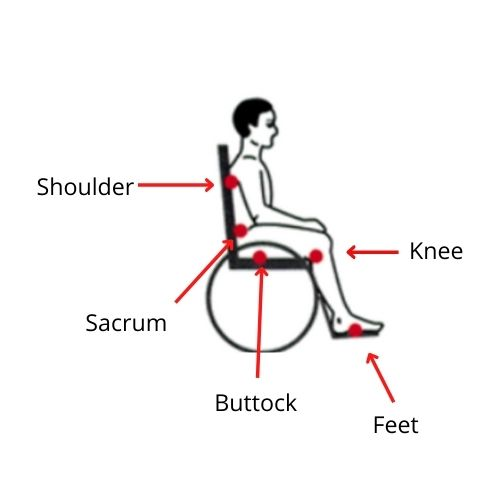Pressure Points for Pressure sores
Posted by Down-Under Wool on 6th Oct 2021
WHICH PRESSURE POINTS ARE AT HIGH RISK OF DEVELOPING PRESSURE SORES?
If there is prolonged pressure on a body part, it can block capillaries, resulting in low blood supply and oxygen levels in that area. As a result, the skin tissues in that area can develop pressure ulcers. People bound to a bed or wheelchair for an extended time are vulnerable to pressure sores.
Are you confined to a bed or wheelchair? Do you know which parts of your body are more likely to develop pressure sores? Keep reading to learn about pressure points.
What are pressure points, and how do you identify them?
Bed sores (also known as pressure sores, pressure ulcers, or decubitus ulcers) are lesions that form on parts of the skin that have been under pressure due to extended lying in bed, sitting in a wheelchair, or wearing a plaster. Those parts of the body are referred to as pressure points. Further, the continuous pressure on an area can block capillaries, resulting in a lack of blood supply and oxygen. As a result, the decay process of cells may start, and pressure ulcers on the skin can develop.
It is simple to pinpoint pressure points. To identify a pressure point, you need to analyze which parts of your body are under pressure, rubbing against sheets or a surface, or moist. For instance, Pressure sores commonly develop where the skin covers bony parts, such as the head, shoulders, back, elbows, wrists, buttocks, hips, knees, heels, and ankles.
In addition to this, a person confined in bed has different pressure points than a person confined to a chair, which will be discussed below. If you want to prevent pressure points from getting bed sores, you must have a soft surface with extra padding and make sure to change your position more often.
To learn more about the causes and prevention of bed sores, read this blog.
Pressure Points for people confined to bed
For persons who are confined to their beds, there are a number of pressure points to consider, which are:
●Back and side of the head
●Shoulders blades
●Back
●Buttocks and Hips
●Inner knees
●Heels and anklesPressure Points for wheelchair users
Following are the common pressure points for bed sores in wheelchair users:
●Shoulder blades
●Spine sacrum or back
●Buttocks or tailbone
●Knees
●Where the backs of the arms and legs rest against the chair
●Feet

How can Down-Under Wool's Products help you relieve pressure points?
If pressure points are exposed to pressure, shear forces, moisture, or friction for a longer duration, they can develop bed sores. This is where Down-Under Wool's products can help you.
Our products are made from superior quality merino wool and medical sheepskin to provide ultimate comfort. We are currently offering a range of products for enhancing comfort and bed sore prevention. These products are excellent for relieving pressure, reducing shear forces, absorbing moisture, improving blood flow, and stopping friction. Consequently, the pressure points do not develop pressure sores.
Summary
In summary, pressure sores are most likely to develop in body parts that have been under continuous pressure and areas where bones are close to the surface. These points are known as the pressure points; and include the head, back, arms, buttocks, knees, and feet. You need to avoid continuous pressure, moisture, friction, and shear forces on pressure points. For that, you must change your position more often and use Down-Under Wool's Medical Sheepskin products to increase comfort.

